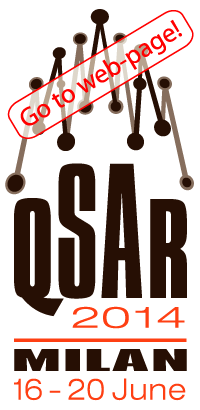See deadlines to be in time with abstract submission, registration and workshop proceedings.
Monday, June 18th, 2012
|
12:00 – |
Registration |
Opening session
|
15:20 – 15:30 |
Opening Words |
|
15:30 – 16:10 |
QSAR and REACH: Problems and Potential ChemQuest, Sandown, Isle of Wight, UK |
|
16:10 – 16:50 |
Environmental QSAR Modeling: Where have you been, where are you going? University of North Carolina at Chapel Hill, Chapel Hill, US |
|
16:50 – 17:10 |
Coffee |
Session 1: Modeling challenges for nanomaterials
Chair person: James Rathman
|
17:10 – 17:50 |
Plenary talk |
|
Deriving relationships between effects and characteristics of nanomaterials Heriot-Watt University, Edinburgh, Scotland, UK |
|
|
17:50 – 18:10 |
Oral presentation |
|
QSAR Investigation of the Potential Biological Activity of Functionalised Nanoparticles University of Insubria, Varese, Italy |
|
|
18:30 – |
Reception |
Tuesday, June 19th, 2012
Session 2: Novel (Q)SAR Approaches I
Chair persons: James Devillers & Sulev Sild
|
8:40 – 9:20 |
Plenary talk |
|
Externally Predictive QSAR Models: Thresholds of Acceptance by Various External Validation Criteria and Critical Inspection of Scatter Plots University of Insubria, Varese, Italy |
|
|
9:20 – 9:40 |
Oral presentation |
|
On the use of atom specific versus molecular descriptors in development of QSARs for PCBs and PCDD/Fs Umeå University, Umeå, Sweden |
|
|
9:40 – 10:00 |
Oral presentation |
|
Category Formation for Respiratory Sensitisation Liverpool John Moores University, Liverpool, England |
|
|
10:00 – 10:20 |
Oral presentation |
|
Computational platform for predicting reactivity profile of chemicals University "Prof. As. Zlatarov", Bourgas, Bulgaria |
|
|
10:20 – 10:40 |
Oral presentation |
|
Towards predictive toxicology – an industrial perspective Syngenta Ltd, Jealott's Hill International Research Centre, UK |
|
|
10:40 – 11:00 |
Coffee, Posters are up |
Session 3: Integrating ADME Predictions into Predictive Toxicology
Chair persons: Igor Tetko & Marjan Vračko
|
11:00 – 11:20 |
Oral presentation |
|
Identification of pregnane X receptor ligands by QSAR analysis and correlations with genotoxicity, endocrine disruption and teratogenicity Technical University of Denmark, Søborg, Denmark |
|
|
11:20 – 11:40 |
Oral presentation |
|
Coping with Unbalanced Datasets in Modeling Oral Absorption Universities of Kent and Greenwich, Chatham, Kent, UK |
|
|
11:40 – 12:00 |
Oral presentation |
|
Predicting in vivo liver genotoxicity and in vivo bone marrow micronucleus formation simulating in vivo metabolism University "Prof. As. Zlatarov", Bourgas, Bulgaria |
|
|
12:00 – 12:20 |
Oral presentation |
|
Novel antimalarial drug candidates generated in silico by analysis of public HTS data Simulations Plus, Inc., USA |
|
|
12:20 – 12:40 |
Oral presentation (s) |
|
In-silico pharmacokinetic studies on dermal exposure to coumarin and other cosmetic additives: An integrated approach to model kinetics within living systems EC – JRC, Institute for Health & Consumer Protection, Ispra, Italy |
|
|
12:40 – 14:00 |
Lunch |
Session 4: Cheminformatics Solutions for Environmental and Health Sciences
Chair persons: Aleksander Tropsha & Jurii Sushko
|
14:00 – 14:20 |
Oral presentation |
|
It is all about SVM, Signatures, and Bioclipse AstraZeneca R&D, Södertälje, Sweden |
|
|
14:20 – 14:40 |
Oral presentation |
|
Development of a Knowledge-based System for Predicting Toxicity in Tetrahymena pyriformis Lhasa Limited, Leeds, UK |
|
|
14:40 – 15:00 |
Oral presentation (s) |
|
Prioritization of chemicals according to their PBT profile University "Prof. As. Zlatarov", Bourgas, Bulgaria |
|
|
15:00 – 15:20 |
Oral presentation |
|
ToxML, a Data Exchange Standard with Content Controlled Vocabulary Used to Build Better (Q)SAR models Lhasa Limited, Leeds, UK |
|
|
15:20 – 15.40 |
Oral presentation |
|
Electronic organization and archiving of QSAR/QSPR model information University of Tartu, Tartu, Estonia |
|
|
15:40 – 16:10 |
Coffee & Posters |
|
16:10 – 18:10 |
Poster Session |
|
19:00 – |
Walking Tour (about 1.5-2h) |
Wednesday, June 20th, 2012
Session 5: Toxicology Data, Curation & Mining
Chair persons: Ralph Kühne & Lothar Terfloth
|
9:00 – 9:40 |
Plenary talk |
|
Linking the silos: Data and predictive models integration in toxicology Ideaconsult Ltd., Sofia, Bulgaria |
|
|
9:40 – 10:00 |
Oral presentation |
|
Online database of toxicological structure alerts eADMET GmbH, Neuherberg, Germany |
|
|
10:00 – 10:20 |
Oral presentation |
|
Development of a Chemical Hazards Database for Risk Assessments in Food and Feed S-IN Soluzioni Informatiche, Vicenza, Italy |
|
|
10:20 – 10:40 |
Oral presentation (s) |
|
Data series mining of toxicity data from scientific articles – from data point timelines to well curated dataset – on example of published T.Pyriformis data. University of Tartu, Tartu, Estonia |
|
|
10:40 – 11:00 |
Coffee & Posters |
Session 6: Modelling Environmental Toxicity and Fate
Chair persons: Taravat Ghafourian & Ester Papa
|
11:00 – 11:40 |
Plenary talk |
|
QSAR Modeling of Juvenoids: Successes, Failures and Prospects CTIS, Rillieux La Pape, France. |
|
|
11:40 – 12:00 |
Oral presentation |
|
Modelling Hydrophobicity Contributions of Cationic Fragments to LogP, and Application to QSAR for aquatic toxicity to cationic surfactants Liverpool John Moores University, Liverpool, UK |
|
|
12:00 – 12:20 |
Oral presentation |
|
Ecotoxicity QSARs Based on Partial Charge Descriptors National Institute for Environmental Studies, Tsukuba, Japan |
|
|
12:20 – 12:40 |
Oral presentation |
|
Screening for Low Aquatic Bioaccumulation: Applicability Domains and Prediction Confidence of the BCF Waiving Scheme Analytisches Laboratorium, Luhnstedt, Germany |
|
|
12:40 – 14:00 |
Lunch |
Session 7: Novel (Q)SAR Approaches II
Chair persons: Chihae Yang & Steve Enoch
|
14:00 – 14:40 |
Plenary talk |
|
QSPRs and QPPRs for developing physiologically-based pharmacokinetic models: Progress to-date and Challenges ahead Université de Montréal, Canada |
|
|
14:40 – 15:00 |
Oral presentation |
|
An integrated model for ready biodegradability for regulatory use Istituto di Ricerche Farmacologiche Mario Negri, Milano, Italy |
|
|
15:00 – 15:20 |
Oral presentation |
|
Improving uncertainty assessment of QSAR models: the impact of experimental error on individual predictions METO, INERIS, Verneuil en Halatte, France. |
|
|
15:20 – 15:40 |
Oral presentation |
|
Consensus Prediction of Toxicity for large and structurally diverse datasets U.S. Environmental Protection Agency, Cincinnati (OH), USA |
|
|
15:40 – 16:00 |
Oral presentation |
|
Predicting Mixture Toxicity University "Prof. As. Zlatarov", Bourgas, Bulgaria |
|
16:20 – 20:00 |
Excursion to Estonian Open Air Museum |
Thursday, June 21th, 2012
Session 8: Read-Across as a Solution for Filling Data Gaps
Chair persons: Sabcho Dimitrov & Judith Madden
|
9:00 – 9:40 |
Plenary talk |
|
Use of Read-Across in Filling Data Gap for Assessments Safety and Environmental Assurance Centre, Unilever, England |
|
|
9:40 – 10:00 |
Oral presentation |
|
Read-Across Model to Predict the Octanol/Water Partition Coefficient Helmholtz Centre for Environmental Research - UFZ, Leipzig, Germany |
|
|
10:00 – 10:20 |
Oral presentation |
|
Hazard Evaluation Support System for Predicting Repeated Dose Toxicity Using Toxicological Categories National Institute of Technology and Evaluation, Tokyo, Japan |
|
|
10:20 – 10:40 |
Oral presentation (s) |
|
Formation of Chemicals Categories for Organ-Level Toxicity Employing the Adverse Outcome Pathway Approach Liverpool John Moores University, Liverpool, England |
|
|
10:40 – 11:00 |
Coffee & Posters |
Session 9: Prediction of Chronic Toxicity and Organ Level Effects
Chair persons: Patrik Andersson & Uko Maran
|
11:00 – 11:40 |
Plenary talk |
|
Strategies for the In Silico Prediction of Liver Toxicity Liverpool John Moores University, Liverpool, England |
|
|
11:40 – 12:00 |
Oral presentation |
|
Stratified Prediction of Drug Toxicity through 3D Liver Models Insilico Biotechnology AG, Stuttgart, Germany |
|
|
12:00 – 12:20 |
Oral presentation (s) |
|
Predicting protein binding potency by using DPRA reactivity data University "Prof. As. Zlatarov", Bourgas, Bulgaria |
|
|
12:20 – 12:40 |
Oral presentation |
|
Drugs, Non-Drugs, and Disease Category Specificity: Organs Effects by Ligand Pharmacology University of Tartu, Tartu, Estonia |
|
|
12:40 – 14:00 |
Lunch |
Session 10: Safety and risk assessment solutions for food and cosmetics
Chair persons: Giuseppina Gini & Nina Jeliazkova
|
14:00 – 14:40 |
Plenary talk |
|
The applicability of the Threshold of Toxicological Concern (TTC) to chemicals in food and cosmetics EC - JRC, Institute for Health & Consumer Protection, Ispra, Italy |
|
|
14:40 – 15:00 |
Oral presentation |
|
Design and Development of an Institutional Knowledge-base for Chemical Evaluation and Risk Estimation in Food Safety US FDA CFSAN, USA |
|
|
15:00 – 15:20 |
Oral presentation |
|
A Mode-of-Action-based QSAR approach to toxicity models implemented in Chemical Evaluation and Risk Estimation System Altamira LLC, USA |
|
|
15:20 – 15:40 |
Oral presentation |
|
Integrated Workflow to Predict Reactive Toxicity of Toxicants and Their Metabolites Molecular Networks GmbH, Erlangen, Germany |
|
|
15:40 – 16.10 |
Student award election results |
|
Best poster presentation |
|
|
16:10 – 16:30 |
Coffee & Posters |
Session 11: (Q)SAR in Adverse Outcome Pathways & Future Perspectives of (Q)SAR
Chair person: Kannan Krishnan
|
16:30 – 17:10 |
Plenary talk |
|
Integrating QSAR models into Adverse Outcome Pathways OECD, Environmental Health and Safety Division, Paris, France |
|
|
17:10 – 18:10 |
Round Table Discussion |
|
Future Perspectives of (Q)SAR - towards new ideas, solutions and challenges |
|
|
18:10 – 18:20 |
Presentation of QSAR-2014 |
|
19:30 – |
Grand Feast Of The Honorables (Banquet), |
Friday, June 22th, 2012
Session 12: Novel (Q)SAR Approaches III
Chair persons: Emilio Benfenati & Villem Aruoja
|
9:20 – 10:00 |
Plenary talk |
|
Read-across, Structural Alert and Consensus Prediction of Acute Fish Toxicity – Opportunities for Reducing Animal Testing Helmholtz Centre for Environmental Research, Leipzig, Germany |
|
|
10:00 – 10:20 |
Oral presentation |
|
Automatic knowledge extraction from chemical structures: the case of mutagenicity prediction Politecnico di Milano, Milano, Italy |
|
|
10:20 – 10:40 |
Oral presentation |
|
Tautomerism and QSAR: Implementation in OECD QSAR Toolbox University "Prof. As. Zlatarov", Bourgas, Bulgaria |
|
|
10:40 – 11:00 |
Coffee |
Session 13: Regulatory Use of (Q)SARs
Chair persons: Mark Cronin & Gerrit Schüürmann
|
11:00 – 11:40 |
Plenary talk |
|
The use of QSARs under REACH after the first registration deadline European Chemicals Agency (ECHA), Helsinki, Finland |
|
|
11:40 – 12:00 |
Oral presentation |
|
Free QSARs in Regulatory Eco/Toxicology: Feedback from Users EquiTox, Lyon, France |
|
|
12:00 – 12:20 |
Oral presentation |
|
Documentation of in-silico methods for regulatory issues: Practical Examples and suggestions German Federal Environment Agency, Dessau-Roßlau, Germany |
|
|
12:20 – 12:40 |
Oral presentation |
|
A quantitative weight-of-evidence approach used in decision support for safety and risk assessment Chemical and Biomolecular Engineering, Ohio State University, USA |
|
|
12:40 – 13:00 |
Closing Remarks |
|
13:00 – 14:30 |
Farewell Lunch |










